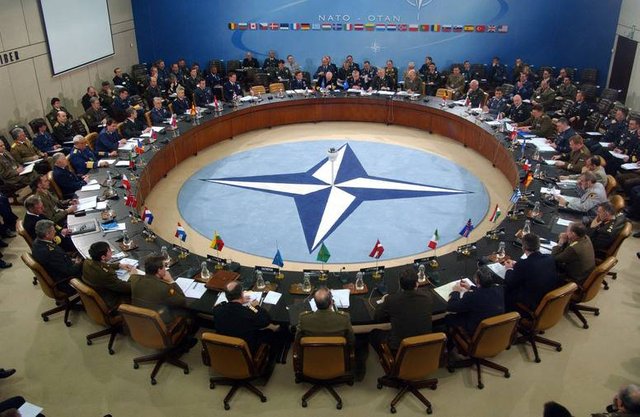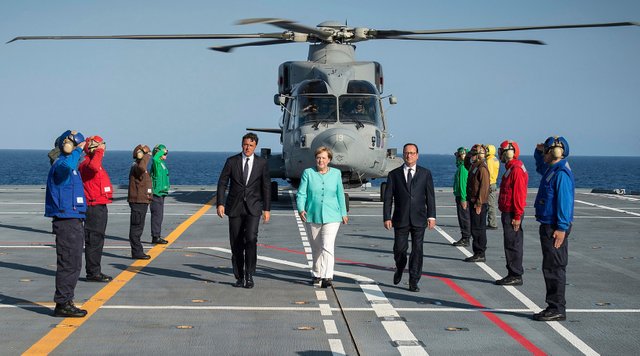Zivilschutz oder doch Zivilbereitschaft? Stichwort "civil preparedness" by NATO

Vor einer Woche waren die Zeitungen voll mit dem neuen Zivilschutzkonzept der Bundesregierung. Tagelang wurde über Notvorräte berichtet, auf Facebook wurde mit dem Hashtag Hamsterkäufe und dazu passenden Bildern rumgeblödelt. Die Medienwirksamkeit war riesig, sogar die ausländische Presse berichtete. Und doch wurde das Ganze am Ende heruntergespielt - "Ist ja alles gar nicht so schlimm".
Hier mein Bericht dazu. Leider ist dabei das Thema Vorratsdatenspeicherung komplett untergegangen - hätte wohl einen eigenen Beitrag verdient gehabt.
Aber was hat das Ganze nun auf sich?
Diese Frage beantwortet uns die NATO auf ihrer Website (wer von uns liest schon ellenlange Texte auf der Website der NATO und das noch in englisch?)
Civil preparedness
The effective transportation of forces and military equipment relies on civil resources and infrastructure, such as railways, ports, airfields and grids. These assets are vulnerable to external attack and internal disruption. Civil preparedness means that basic government functions , can continue during emergencies or disasters in peacetime or in periods of crisis. It also means that the civilian sector in Allied nations would be ready to provide support to a NATO military operation.
- Under Article 3 of the North Atlantic Treaty, all Allies are committed to building resilience, which is the combination of civil preparedness and military capacity.
- Allies agreed baseline resilience requirements in seven strategic sectors – continuity of government, energy, population movements, food and water resources, mass casualties, civil communications and transport systems.
- To deter or counter potential threats or disruption to the civil sector, effective action requires clear plans and response measures, defined well ahead of time and exercised regularly.
- That is why there is a need to complement military efforts to defend Alliance territory and populations with robust civil preparedness.

Strategic areas
NATO civil preparedness is primarily concerned with aspects of national planning which affect the ability to contribute to Allied efforts in continuity of government, continuity of essential services to the population and civil support to military operations.
These three critical civilian functions have been translated into seven baseline resilience requirements and agreed by NATO in February 2016. Together with a package of resilience guidelines, assessment and a tailored toolbox, their objective is to support nations in achieving national resilience and provide benchmarks against which to assess the state of civil preparedness. These are:
- Continuity of government and critical government services;
- Energy supplies;
- Ability to deal effectively with uncontrolled movement of people;
- Food and water resources;
- Ability to deal with mass casualties;
- Telecommunications and cyber networks;
- Transportation systems.
These baseline resilience requirements will be further discussed by Allies in the run-up to NATO Summit in Warsaw in July 2016.
Und wann wurde das Ganze beschlossen?
Warsaw Summit Communiqué
Issued by the Heads of State and Government participating in the meeting of the North Atlantic Council in Warsaw 8-9 July 2016
[...]
[73.] Today we have made a commitment to continue to enhance our resilience and to maintain and further develop our individual and collective capacity to resist any form of armed attack. Civil preparedness is a central pillar of Allies' resilience and a critical enabler for Alliance collective defence. While this remains a national responsibility, NATO can support Allies in assessing and, upon request, enhancing their civil preparedness. We will improve civil preparedness by achieving the NATO Baseline Requirements for National Resilience, which focus on continuity of government, continuity of essential services, security of critical civilian infrastructure, and support to military forces with civilian means. In this context, we welcome the Resilience Guidelines approved by Defence Ministers in June 2016.
[...]
nato.int
Es geht hier also eben nicht um Zivilschutz oder Katastrophenschutz, sondern um Zivilbereitschaft.
Zivilbereitschaft ist als Einbindung von zivilen Organisationen in militärische Strukturen definiert und Teil der NATO-Doktrin einer "national resilience" (nationale Widerstandsfähigkeit / Durchhaltevermögen). Der Unterschied zum Zivilschutz besteht in der Einrichtung einer zivilen Unterstützung von militärischen Operationen ("civil support to military operations").
Vor allem die Sicherstellung der Punkte
- eine effektive Bewältigung von ungeregelten Massenbewegungen (Ability to deal effectively with uncontrolled movement of people)
und - Bewältigung von Massenanfällen von Verletzten (Ability to deal with mass casualties)
sollte einen aufhorchen lassen.
Die Umsetzung soll auf nationaler Ebene der NATO-Mitglieder erfolgen. Die Meldung durch "vertrauliche Dokumente" ist als Versuch zu werten, das vermeintlich harmlose Zivilschutzkonzept in verschiedene Themen aufzuteilen, obwohl es dieselbe Sache ist.

Zwischendurch trafen sich übrigens Merkel, Renzi und Hollande zu Europagesprächen auf dem Flugzeugträger "Garibaldi". Vor beeindruckender Kulisse bemühten sich alle drei um eine starke Symbolik. Ihre Botschaft: "Wir müssen mehr für die Sicherheit tun".
Vor 75 Jahren, im August 1941 auf dem britischen Schlachtschiff „Prince of Wales“ vor der Küste Amerikas, trafen sich Großbritanniens Premier Churchill und der amerikanische Präsident Roosevelt und verhandelten dort, mit großer Sorge wegen des seinerzeit noch siegreichen Hitler-Regimes, die Atlantik-Charta. Sie wurde am 14. August verkündet und bildet die Grundlage der Nachkriegsordnung der Welt.
Auf einem Kriegsschiff Politik zu machen, besitzt hohen Symbolcharakter, es drückt Wehrhaftigkeit und Entschlossenheit aus.
Ab November werden übrigens die ersten Übungen für Einsätze der Bundeswehr im Inneren zur Terrorabwehr stattfinden.
Dies soll keine Panikmache sein, sondern nur eine Bitte das Ganze etwas ernster zu nehmen. Ob Finanzcrash, Krieg oder bürgerkriegsähnliche Verhältnisse, irgendetwas wird (leider) kommen. Die Frage ist nur wann und wie schwer es uns treffen wird.
Bleibt wachsam!